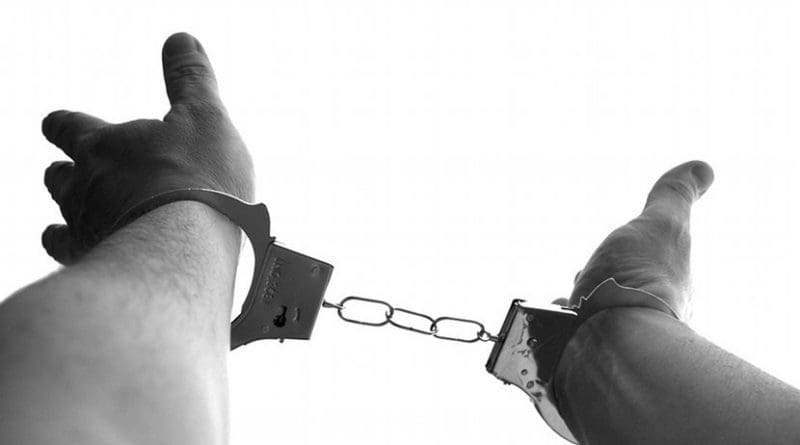Protestors Win In 2004 RNC Protest Mass Arrest Case In NYC – OpEd
On the morning of the big march through midtown Manhattan on the opening day of the Republican National Convention in New York City in 2004, I and a few friends were having breakfast at a little coffee shop near 96th Street on the Upper West Side. We had a few homemade signs and were clearly headed for a political action. Across from us were three New York City cops, carrying riot helmets, having their breakfast. They were clearly headed to the same place we were.
After we had finished our breakfasts, we all headed for the subway — the cops and us. We ended up seated across from each other on a downtown train.
Each of the cops had a bag. I asked one of them what he had in the bag. He reached in and pulled up a big fistful of white nylon handcuff straps of the kind favored by police for mass arrests — the kind made of almost unbreakable plastic straps with slip-tight ridges on them so that the arresting officer can yank it tight so that the only way to remove it is to cut it off.
“I see you’re prepared for a lot of arrests,” I said.
“Yeah,” he replied. “We’re ready for you!”
“Well, don’t arrest us when you see us!” I said.
The officer smiled.
As it turns out, none of us was arrested, but hundreds of marchers were. The bags of cuffs those officers were carrying makes it clear that was the city’s intention from the outset.
Yesterday, eight years after that march, a federal judge ruled that the mass arrests, made in sweeps by the police, were illegal, violating the probable cause requirement inherent in the Fourth Amendment of the Bill of Rights.
As Judge Richard J. Sullivan wrote in a 32-page opinion, “An individual;s participation in a lawbreaking group may, in appropriate circumstances, be strong circumstantial evidence of that individual’s own illegal conduct,” but no matter the circumstances, an arresting officer must believe that every individual arrested personally violated the law. Nothing short of such a finding can justify arrest. The Fourth Amendment does not recognize built by association.”
The ruling was not a complete win. Judge Sullivan rejected the claim by plaintiffs in the false-arrest lawsuit that their First Amendment rights to freedom of expression, freedom of assembly and freedom to seek redress for grievances had been violated by the mass arrests, but lawyers for the plaintiffs said it was nonetheless a strong blow against the increasingly common police tactic of mass arrests of protesters in demonstrations. Christopher T. Dunn, a lawyer with the New York Civil Liberties Union, who represented some of the victims of the arrests, said the judge, in his ruling, had “emphatically rejected the city’s claim that it could make mass arrests of protestors.”
Of course, since those 2004 mass arrests at the 2004 RNC protests, there have been many more mass arrests in New York, as the city’s mayor, Michael Bloomberg, has taken a tough line against protest. This has been particularly true over the past year of Occupy Wall Street protests, where police have been particularly aggressive in not only arresting but brutalizing protesters against the big financial corporations that have collectively wrecked and pillaged the US economy.
While the judge’s slapdown of one mass arrest by the NYPD is an important legal win for the right to protest, the fact that it took eight years to get that judgement diminishes it significantly. The reality is that police in New York and in cities across the country, and the authorities who order them to block Constitutionally-protected political protests, don’t really care much about legalities. They realize that they can act with almost complete impunity to break up protests and intimidate activists through brutality and mass arrests, lock up demonstrators for a day or longer to get them off the streets, as was the case in this particular incident brought before Judge Sullivan, and just pay the penalty later (the judge has yet to fine New York City for its violation of the plaintiffs’ Fourth Amendment rights, and to decide whether to issue an injunction against such mass arrests in the future). And of course, the city can still drag things out further by appealing Sullivan’s ultimate decision, including any injunction, and his ruling could be overturned–though it may just prefer to accept the judgement since if it were upheld on appeal, it would then be binding for the whole circuit, which encompasses all of New York State, Connecticut and Vermont. It could also be cited as a precedent in arguments by plaintiffs in mass arrest cases anywhere in the country.
We just saw the same tactic of mass arrests employed at a protest against Walmart, in Elwood, Illinois, where 650 people rallied to support striking Walmart warehouse workers protesting “poverty wages,” sexual harassment and extreme work conditions.” Police in riot gear there, working in tandem with Walmart private security goons, surrounded, roughed up and arrested demonstrators and threatened others with “chemical or less lethal munitions” if they didn’t disperse.
Police state-tactics have become the default response in today’s America to peaceful protest.
While one federal judge’s ruling against the practice is a step in the right direction, there are many, many steps being taken in the wrong direction all the time.
Unless all Americans wake up to what is happening to policing in this country, and to the way political authorities are trashing basic civil liberties in order to repress dissent, the day will come when any two people with a sign will find themselves being tackled and hauled off to jail — the situation that prevails in places like China, Cuba, Burma or Saudi Arabia.

